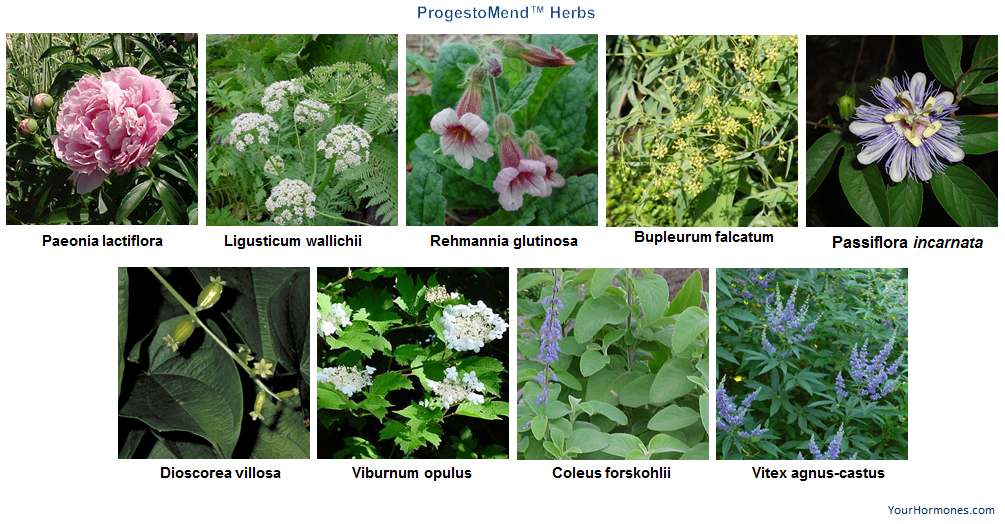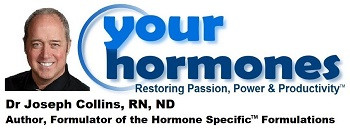
ProgestoMend™ Herbs
Paeonia lactiflora: (Chinese Peony) contains a number of constituents, including benzoflavone, that mimic the calming, soothing and antispasmodic properties of progesterone. It has traditionally been used to improve hypermenorrhea, dysmenorrhea and to shrink uterine myomas. Similar to progesterone, it is effective in relieving restlessness, irritability, anxiety and insomnia, while at the same time exhibiting aphrodisiac and libido- enhancing properties. Similarly, it also has antiasthmatic properties.
Ligusticum wallichii: (Chuan Xiong) has significant progestogenic activity and is a potent and specific activator of the progesterone receptor. It is used for treatment of conditions requiring progesterone action, and for progesterone-replacement therapy. Like progesterone, it has anti-fibrotic and antiproliferative properties. Traditional Chinese Medicine uses it for “dispersal of tissue stasis, removal of chronic inflammation and facilitation of tissue perfusion” and to maintain healthy blood pressure and healthy heart rhythm due to its progesterone mimicking properties.
Rehmannia glutinosa: (Di Huang) promotes daily progesterone production by enhancing function of the adrenal function, a primary site for progesterone production. Like progesterone, Rehmannia has been shown to stimulate the proliferation and activities of osteoblasts, while inhibiting the the resorptive activities of osteoclasts. Its progesterone mimicking properties include antiallergy, anti-inflammatory, neuroprotective, cardioprotective and antitumor. Rehmannia normalize blood sugar imbalances and improve glucose tolerance by influencing neuroendocrine adrenal function.
Bupleurum falcatum: (Chinese Thoroughwax) can promote daily progesterone production due to one of its constituents, saikogenin A, which can stimulate the hypothalamic-pituitary- adrenal system to by promoting the release of adrenocorticotropic hormone (ACTH). ACTH is responsible for maintaining the size and function of the adrenal gland and the daily production of progesterone, as well as other adrenal hormones. As a progesterone mimetic it has anti-inflammatory actions including inhibitory activity against allergic asthma.
Passiflora incarnata: (Passion Flower) is a functional mimetic of progesterone, mimicking the gabanergic properties of progesterone. It contains constituents such as benzoflavone that exhibit calming, soothing and antispasmodic & antiasthmatic properties. It also contains apigenin a phytoprogesterone with anxiolytic and possibly neuroprotective properties. Like progesterone, It is effective for restlessness, irritability, anxiety and insomnia, while also exhibiting aphrodisiac & libido-enhancing properties.
Dioscorea villosa: (Wild yam) mimics the antispasmodic and anti-inflammatory properties of progesterone, and is able to relieve inflammatory and spasm conditions of the female reproductive organs or any pains caused by spasm. Like progesterone, it can relax the autonomic nervous system and decrease vasomotor symptoms such as hot flushes and night sweats which are associated with autonomic dysfunction. Diosgenin, An active constituent, diosgenin, has antitumor and antiproliferative activity, similar to progesterone.
Viburnum opulus: (Cramp Bark) contains a number of constituents that mimic the antispasmodic properties of progesterone including scopoletin which has anti-inflammatory and anxiolytic activity. Viopudial and viburnin also mimic the antispasmodic properties of progesterone. Traditional use of Viburnum opulus includes dysmenorrhoea, threatened miscarriage, and ovarian pain. Recent research indicates that Viburnum opulus also has significant antioxidant properties with potent gastroduodenoprotective activity.
Coleus forskohlii: (Indian Coleus) promotes progesterone production through the action of forskolin, a constituent that has been shown to stimulate production of progesterone in human adrenal gland tissue. Serum progesterone levels were actually increased in a small study of 20 women taking forskolin. Forskolin exhibited many progesterone mimicking properties, such as antiallergy, anti-asthma, antiglaucoma, antihypertensive & antispasmodic actions. Forskolin and stigmasterol, have both exhibited anticarcinogenic properties.
Vitex agnus-castus: (Chasteberry) promotes progesterone production and can improve levels of progesterone during the luteal phase of menstruating women. Vitex agnus-castus binds to both estrogen and progesterone receptors of endometrial cells but did not induce estrogenic activity (estrogen receptor antagonist), and did stimulate progesterone receptors (progesterone receptor agonist). It inhibits excessive prolactin secretion, is used to treat breast pain, and has cytotoxic activity against human breast cancer & other cancer cells.
